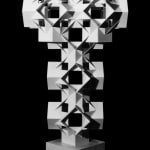 Sketch showing possible placement and size
Sketch showing possible placement and size
David Eisenhauer Swedish-American, b. 1940
Further images
-
(View a larger image of thumbnail 1
)

-
(View a larger image of thumbnail 2
)

-
(View a larger image of thumbnail 3
)

-
(View a larger image of thumbnail 4
)

-
(View a larger image of thumbnail 5
)

-
(View a larger image of thumbnail 6
)

-
(View a larger image of thumbnail 7
)

-
(View a larger image of thumbnail 8
)

-
(View a larger image of thumbnail 9
)

Presented here are several variations, each relying on a “magic angle” that Eisenhauer calculated mathematically. The possibilities for form and scale are virtually limitless—from large-scale sculptures in Corten steel for park settings to smaller, intricate models.
This is a project the gallery has been developing with the artist over several years, with the goal of bringing this sculpture to life.
More information is available upon request.







